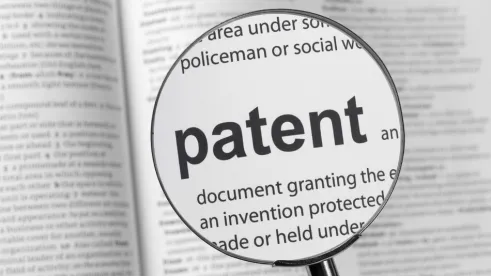In BTG International Limited v. Amneal Pharmaceuticals LLC, (Fed. Cir. Slip Op. 2019-1147, May 14, 2019), the Federal Circuit held that U.S. Patent No. 8,822,438 (“the ‘438 Patent”) was invalid as obvious over the prior art. The ‘438 Patent claims a method for the treatment of prostate cancer comprising the administration of therapeutically effective amounts of abiraterone acetate and prednisone. Appellant was unsuccessful in convincing the Federal Circuit that claims were improperly construed and that absent this error, the claims would have been upheld as valid.
The Representative Claim
The ‘438 Patent entitled “Methods and Compositions for Treating Cancer” is directed to a method comprising administering a 17α-hydroxylase/C17,20-lyse [(CYPT17)] inhibitor, such as abiraterone acetate (“abiraterone”) in combination with at least one additional therapeutic agent such as an anti-cancer agent or a steroid. Slip Op. at 8. The therapy is taught to provide more effective ways to treat cancer, for example, breast and prostate cancer. In addition, the combined therapy is a more effective treatment option for treatment-resistant patients and those who have suffered recurrence. Id.
The ‘438 specification defines an “anticancer agent” as “any therapeutic that directly or indirectly kills cancer cells or directly or indirectly prohibits[,] stops[,] or reduces the proliferation of cancer cells.” Id., citing the ‘438 Patent at column 4, lines 8-11. Prednisone is listed as a possible anti-cancer agent. Id., citing the ‘438 Patent at column 3, lines 16 and 19.
Independent claim 1 was selected as representative. It recites:
“A method for the treatment of a prostate cancer in a human comprising administering to said human a therapeutically effective amount of abiraterone acetate or a pharmaceutically acceptable salt thereof and a therapeutically effective amount of prednisone.”
Emphasis added. Slip Op. at 8-9, citing the ‘438 Patent at column 16, lines 16-20.
What is a Treatment?
The patent was challenged in three separate inter partes review (“IPR”) proceedings and in a bench trial before the U.S. District Court for the District of New Jersey.
The central issue in the underlying IPR proceedings and before the district court was whether a person having ordinary skill in the relevant art (“PHOSITA”) would have known from the references1 that the steroid prednisone could be used as a solo cancer treatment. Slip Op. at 12. Under the “broadest reasonable interpretation (“BRI”) standard, the terms “treat,” “treating,” and “treatment” required the “eradication, removal, modification, management or control of a tumor or primary, regional, or metastatic cancer cells or tissue and the minimization or delay of the spread of cancer.” Emphasis added. Slip Op at 12. The PTAB also found that treatment was not limited to the drug’s primary effect on the cancer, but also “perhaps by an anti-cancer effect, or perhaps by some other mechanism.” Id. Under this construction, the claims were held invalid by the PTAB as obvious to a PHOSITA. The PTAB found that the use of the term “comprising” in the claim includes eradication of the tumor by conventional anti-cancer agents and that treatment by steroids can also refer to other treatments included in the construction, that is, an anti-cancer effect that may work by some other mechanism. Id.
The N.J. district court denied Appellant’s motion to stay the litigation pending the result of the IPRs. The district court also found the claims obvious, reasoning that abiraterone had been identified in the prior art as a second-line prostate cancer treatment, and it was known in the art that it could be swapped for ketoconazole (as taught by the prior art) because it functioned in a parallel function in a more targeted manner. The district court also determined that to a PHOSITA, the prior art would suggest that abiraterone could be combined with prednisone with a reasonable probability of success. Slip Op. at 13.
Claims Correctly Construed
On appeal to the Federal Circuit, Appellant argued that the PTAB’s construction was erroneous because the Board broadly interpreted the term “treatment” to include palliative effects and reducing side effects of co-administration abiraterone because the claims only require having at least one anti-cancer effect. Slip Op. at 15. The Federal Circuit noted that the ‘438 specification, claims, and prosecution history teach that treatment includes both anti-cancer effects or reduction in side effects of a different anti-cancer drug. The court also pointed that the ‘438 specification states that a therapeutic agent may be either an anti-cancer agent or a steroid. As such, the court stated that “the use of ‘or’ in between ‘anti-cancer agent’ suggests that the steroid is not the same as an anticancer agent.” Slip Op. at 16. The court also noted that the specification explains that prednisone is an anti-cancer agent and a steroid, and that as such, the anti-cancer effects of the steroids includes the long-familiar effects of palliation and reduction of side effects. Slip Op at 17. The prosecution history did not contradict this construction. In sum, the Federal Circuit held that claims were correctly construed to cover a therapy wherein “abiraterone has an anti-cancer effect, while prednisone either has its own anti-cancer effect or has a palliative/side-effect reducing effect.” Slip Op. at 19.
Finding that the claims cover methods for treating prostate cancer by co-administration of abiraterone and prednisone, the Federal Circuit agreed with the PTAB and the district court that the claims were obvious over the prior art which taught each limitation of the claims. Appellant did not contest this, but rather argued that the prior art did not teach a combination therapy where each agent produces an anti-cancer effect in combination. The Federal Circuit disagreed because under the court’s construction, the prior art need not teach that prednisone must have an anti-cancer effect. Slip Op. at 21-22.
It remains to be seen whether any Appellant will request a rehearing en banc and continue to challenge the claim construction.




 />i
/>i

